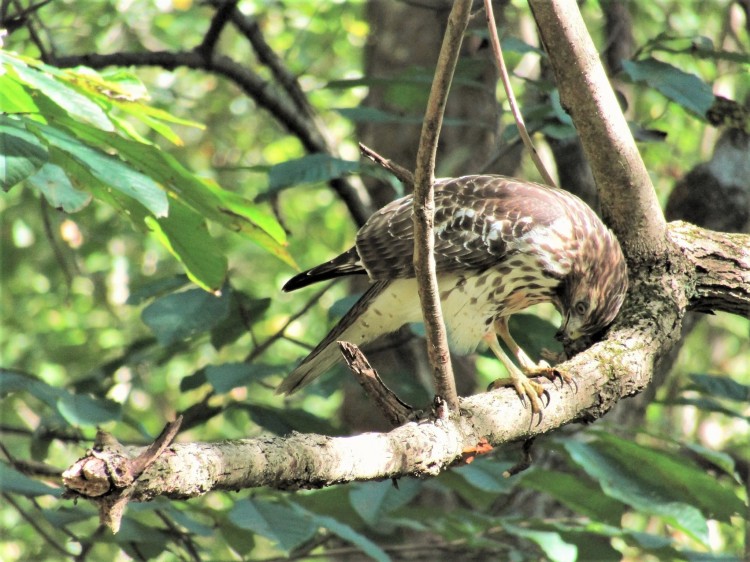
The Red-shouldered is a forest hawk, smaller than the Red tailed hawk but larger than the Cooper’s. Find a bottomland forest with an open understory, near water, and there you may see them. Fortunately their habitat needs are a perfect match for this little forest, so the noisy calls of at least one resident pair can be heard throughout the year. And they’re successfully raising young too – yesterday I was lucky enough to see this young Red-shouldered hawk apparently off fending for itself.
In the opening pic she’s busy wiping her beak on the branch, to remove the mess of a just completed meal.

You can see a portion of it in her beak as she scarfs it down. The image is too blurry to determine just what she’s eating, but it looks vaguely grey and furry like a mouse or vole. If she caught it herself that’s a very good sign – the hardest challenge for young hawks is to become good hunters, and less than half survive their first year. She (I don’t actually know the gender of this hawk) likely hasn’t been on her own for long, since Red-shouldered parents will continue to bring food to their young till they are up to nineteen weeks old.

And she isn’t entirely on her own, since at the completion of the meal she lifted her head to scan for her parents, who began calling nearby. Red-shouldered hawks are some of the most vocal of North American raptors; their calls are often mimicked by Blue jays.

She called in reply just before taking wing. Though it’s possible her parents provided that mouse, I like to think she was proudly announcing what a successful hunter she’d become.

Jeff Mattingly
Awesome young Red-shouldered Hawk photos! One of my favorite raptor species.
LikeLiked by 1 person
oneforestfragment
Mine too!
LikeLike
Phyllis Fitzgerald
I was hoping to see some tail feathers in flight, as I sometimes mistake them in flight & underbelly with a red tailed hawk. How do you distinguish between them in flight?
LikeLiked by 1 person
oneforestfragment
I’m not a raptor expert by any means – in this case habitat was the main factor, since Red-tailed hawks aren’t usually in the woods. In flight an adult Red-shouldered hawk is barred with rusty orange below, and is smaller and less stocky than a Red-tailed.
LikeLike
Jim Sky
I hope I can someday learn to tell these hawks apart. All of the variation between juveniles and adults doesn’t help me. But these are great pictures. I assume you were very close or had a telephoto lens of some sort (or both).
Off topic. Has anyone been seeing coyotes this year?
LikeLiked by 1 person
oneforestfragment
I was close – my camera is a small canon with an extendable lens, not the best for bird pictures but it’s very portable. I have been seeing coyote scat on the trails here, that’s as much as I ever see of them!
LikeLike
Anonymous
Good shots!
LikeLiked by 1 person
Michael Smith
I have always liked red shoulders. Since some red shoulder habitat was lost near produce road in the late 90s this preserve is very important to help preserve this amazing species. Hope your small urban wild is doing well.
LikeLiked by 1 person
oneforestfragment
They need an open understory for hunting – the habitat has greatly improved for them here, due to bush honeysuckle and privet removal.
LikeLike